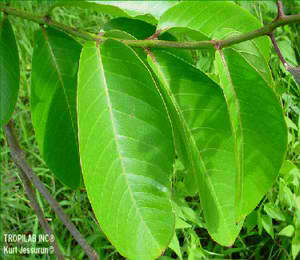

Much effort has gone into controlling these pathogens and their related diseases since the first pathogen, P. musae, was identified as a banana pest in Java Islands in 1902. The other two, P. fijiensis and P. eumusae, were reported in the Sigatoka district of the Fiji Islands in 1963 (thus the name sigatoka) and in Southeast Asia in the 1990s. Black Sigatoka has since spread and is considered the most problematic disease of banana globally.


A team of researchers from the International Institute of Tropical Agriculture (IITA) have compiled these efforts in a paper “Progress in understanding Pseudocercospora banana pathogens and the development of resistant Musa germplasm”, published recently in the Plant Pathology Journal. They also identified areas that need further attention to save banana from these deadly diseases.
According to the paper, these fungi cause streaks on banana leaves that turn necrotic, significantly reducing their ability to photosynthesize. This can lead to 35–100% yield loss, due to poorly filled fruits and smaller and lighter bunches. They also cause premature ripening of the fruit.
Management of the pathogens includes the use of fungicide, but this increases the cost of production by 25–30%. In total, over $550 million is spent annually worldwide on these chemicals, which also pose environmental risks to those working and living near banana plantations.
While non-chemical disease management approaches, such as the use of biological control agents, organic farming, cultural practices, and phytosanitary legislation, exist, they have not been widely adopted as they are often laborious and require specialized equipment that tends to be prohibitive in developing countries.
Traditionally, Pseudocercospora banana pathogens were separated by altitudinal and climatic gradients. P. musae was restricted to higher altitudes with cooler temperatures while P. fijiensis was more prevalent in lower, warmer areas with higher rainfall. However, it appears P. fijiensis has been shifting upwards to higher altitudes and in some cases, has replaced P. musae to become the dominant Pseudocercospora banana pathogen.
This gradual displacement suggests an evolutionary adaptation to either a changing climate or host fitness.
While researchers have suggested that the higher temperatures will increase the areas suitable for banana production by 50% by the year 2070, this may also affect Pseudocercospora banana pathogens and result in increased disease severity as well as the potential for emergence of new pathotypes. Therefore, calling for elaborate surveillance and management programs of these banana pathogens as the most cost-effective option to reduce future impacts.
The paper also looked at efforts to develop banana and plantain varieties with resistance to Pseudocercospora banana pathogens using both conventional and biotechnology methods by several breeding programs which started in 1922.
Most of the efforts have focused on P. fijiensis and some level of resistance or tolerance has been clearly demonstrated. Examples of successful breeding programs include IITA’s improved P. fijiensis-resistant plantain hybrids, known as PITAs, and cooking banana hybrids called BITAs now available in several countries including Nigeria, Uganda, Cameroon, the Ivory Coast, and Ghana.
IITA, in collaboration with NARO-Uganda, has also developed several East-African Highland cooking banana hybrids (referred to as NARITAs). Some of these NARITA hybrids have been tested in Uganda by IITA and NARO and the most promising ones have already been released to farmers.
One of the factors that has led to these successes was the establishment of the International Musa Transit Center (ITC) in Belgium to support sanitization, multiplication, and distribution of genetic stocks from around the globe for breeding programs and to farmers.
These gains have also been made possible by integrating banana breeding with molecular tools due to the complexities of breeding banana, including its sterility, polyploid nature, low seed germination, and narrow genetic base.
To overcome these banana breeding challenges, a number of studies have been exploring transformation and have generated transgenic plants and evaluated them for resistance to Pseudocercospora in vitro in the screenhouse and under limited field conditions.
This has also led to the development of more efficient banana transformation protocols. However, the acceptability of genetically transformed banana still faces resistance from anti-GMO groups and banana-importing countries. Therefore, other options in biotechnology include the use of marker-assisted selection (MAS) to accelerate the germplasm selection process and genome editing.
What is the Main Cause of a Heart Attack? What is its Solution? A heart attack is the blockage of… Read More
In the vast economic arena, one term that often takes center stage, inciting extensive debates and discussions, is the "debt… Read More
De-Dollarization: The Changing Face of Global Finance The financial landscape is in a state of flux, with an intriguing economic… Read More
The curtains closed on a dramatic Bundesliga season with Bayern Munich standing tall once again, clinching their 11th straight title.… Read More
The Unfolding Story of Celine Dion's Health In recent news that has left fans across the globe stunned, iconic singer… Read More
As the echoes of the recent NBA season start to fade, the attention of enthusiasts is firmly glued to one… Read More